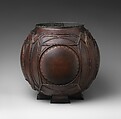Urn
Designer Frank Lloyd Wright American
This copper urn is Frank Lloyd Wright’s finest design in metal. The bold, spherical form with its rhythmic geometric decorative scheme of circles inscribed within squares, framed by lozenges, eloquently expresses his distinctive artistic vision. With this design, dating to the early years of his independent career, Wright achieved harmonious realization of his ideas about ornament. He considered nature his muse and embraced the teachings of the educator Friedrich Froebel (1782-1852) that the essence of nature’s beauty and logic is revealed through geometric shapes. Throughout his career, Wright devoted great attention to decorative objects and furnishings. Dismayed by the inferior designs of commercially available products, he decided to design his own decorative wares. Wright believed passionately that every object and decorative detail had a transformative impact on and was integral to the success of his interiors. With this bold design in copper, he offers a reverent meditation on the natural world. Its form and ornament derive from nature’s essential shapes, while it functions as a vessel for flowers, branches, or stalks gathered from the surrounding landscape. In Wright’s own words, "Whether people are fully conscious of this or not, they actually derive countenance and sustenance from the ‘atmosphere’ of the things they live in or with. They are rooted in them just as a plant is in the soil in which it is planted." (The Natural House, Book II, 1954)
Wright’s sketches reveal he began thinking about this design in the 1890s, and a conceptual sketch for the urn, which is housed in the Frank Lloyd Wright Archives, dates to 1898. It is clearly a design he favored and considered a great success as he featured it in his own Oak Park home and studio, as well as many notable commissions, including the Waller House (1899), the Dana House (1902), Unity Temple (1905), the Coonley House (1907), and Brown’s Bookstore (1908). This urn has a history of coming from the Edward C. Waller House in River Forest, Illinois, one of the earliest commissions for which Wright had the urn design produced. Surviving photographs indicate the Wallers owned at least three of these urns, with one prominently displayed on the newel post of the entry hall and a pair flanking a wide window in the dining room. Correspondence with the Little family indicate they too owned one of these urns, which was displayed in their living room. (See Living Room from the Francis W. Little House (1912-14) https://www.metmuseum.org/art/collection/search/7873)
When Wright presented a version of this urn at the 1902 exhibition of the Chicago Architectural Club, he credited James A. Miller, a Chicago sheet metal worker, as the manufacturer. Wright describes Miller in his In the Cause of Architecture as "a sheet metal worker of Chicago, who had intelligent pride in his material and a sentiment concerning it…At that time I designed some sheet copper bowls, slender flower holders and such things, for him, and fell in love with sheet copper as a building material." It is not known whether Miller produced all of Wright’s spherical urns; however, it seems probable. Notes on the conceptual sketch suggest Wright may have collaborated with Kristian Schneider, a craftsman who modeled ornament for his former employer and mentor, Louis Sullivan. Wright likely presented Miller with designs, instructions, and a model, and together they found ingenious and virtuosic ways to realize his vision. Two iterations of the urn design were produced. This urn is an example of the early version of the design, which features a repoussé bow-tie shaped element in the four upper and four lower horizontal registers. Later, the design was simplified, with the upper and lower registers left blank, and the urn’s proportions were made slightly larger. Today only ten examples of this urn are known to survive— four of the early version, and six of the later design.
The urn reflects Wright’s engagement with the Arts and Crafts movement as well as his belief that architecture should be a gesamtkunstwerk—a total work of art. It was conceived as an integral part of his Prairie style architecture, a distinctive and revolutionary style rooted in the landscape of the Midwest. Not only did Wright want a building’s exterior to correspond harmoniously with its surroundings, but he also designed his interiors to engage with and reflect the exterior landscape. Nature served as Wright’s source of inspiration and creative wellspring, and he sought to apprehend and express nature’s essence in his designs. As a vessel for flowers, weeds, grasses, and other local flora, the urn literally brought nature into the interior, while its form and decoration derive from an exploration of the underlying structures and harmonies of nature. The urn reflects and amplifies the proportions, patterns, shapes, colors, and textures of the space in which Wright placed it. Its circles and squares echo elements of the architecture, harmonizing with the rhythm of the intersecting vertical and horizontal lines. The rich brown surface of the urn also complements the dark, fumed finish Wright used at that time for his oak furnishings and decorative elements. Wright’s design for this urn is inextricably linked to his interiors. The urn engages in a dynamic dialogue with its surroundings, eloquently attesting to Wright’s success at realizing his own soaring ambitions.
Due to rights restrictions, this image cannot be enlarged, viewed at full screen, or downloaded.



